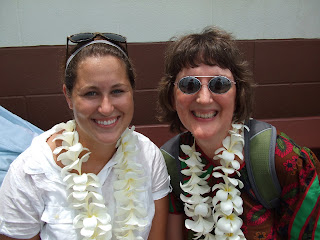It took several false starts. “Tomorrow. We’ll start tomorrow. That is, those teachers who are ready to begin – they will start tomorrow.” After several days of teachers preparing their classrooms and finding textbooks and administrators assigning class sections and preparing rosters, school begins at last.
This is it.
This is what I’m here for. All of the planning, preparation, thinking, arranging; all the getting here; the month of orientation: everything brings me to this moment – to teach.
I arrive at the classroom at 8:15 a.m. sharp, fifteen minutes early. I wait for my first period students in 11th grade honors English 11A to arrive. No one shows up. Not one. Four days after my other classes have begun is the first time I meet any of my first period students. I’ve already stopped asking why things work or don’t work here in the Marshall Islands. Actually, I don’t mind easing into my teaching load, teaching only 4 classes at first – 11th grade English levels B and C before lunch, 10th grade English B and C after lunch. Next week, they tell me, they’ll move 11A to 7th period (2:30 – 3:25) instead of 1st period (8:30 – 9:25). Many of the students are members of the Church of Jesus Christ of Latter-day Saints and have started their day with an early-morning seminary class from 6 – 7 a.m. Whatever. Starting early and ending early would better suit my biorhythm, but it will be fine.
My second period students trickle in. I take my first good luck at their school uniforms: jungle green shirts and black slacks for the boys, matching green pleated skirts and white shirts for the girls. Both boys and girls have the logo for Kwajalein Atoll High School stitched on the shirt pocket – when they wear the uniforms, that is. Besides the ordinary teenage boundary testing, there are the problems of living on Ebeye. A parent of one of my serious students sends in a note: “Please excuse my daughter for not wearing her uniform today. Water problems on Ebeye.” I ask my student whether the rainwater catchments are dry or whether it’s something else, and she shrugs and says, “They’re working on it.”
The students are wonderful – so hungry for learning, so committed to getting an education. But they’re teenagers nonetheless, dealing with normal adolescent issues like hormones and identity, as well as big social issues like high suicide rate, early sexual activity, and readily available mild narcotics. Many of my students already have teeth stained red from beetlenut chewing. I’ve already made it a class rule that going outside to spit will happen between classes, not during my class. One young woman was absent “because she had a miscarriage,” said the school secretary.
School has begun.
This is it.
This is what I’m here for. All of the planning, preparation, thinking, arranging; all the getting here; the month of orientation: everything brings me to this moment – to teach.
I arrive at the classroom at 8:15 a.m. sharp, fifteen minutes early. I wait for my first period students in 11th grade honors English 11A to arrive. No one shows up. Not one. Four days after my other classes have begun is the first time I meet any of my first period students. I’ve already stopped asking why things work or don’t work here in the Marshall Islands. Actually, I don’t mind easing into my teaching load, teaching only 4 classes at first – 11th grade English levels B and C before lunch, 10th grade English B and C after lunch. Next week, they tell me, they’ll move 11A to 7th period (2:30 – 3:25) instead of 1st period (8:30 – 9:25). Many of the students are members of the Church of Jesus Christ of Latter-day Saints and have started their day with an early-morning seminary class from 6 – 7 a.m. Whatever. Starting early and ending early would better suit my biorhythm, but it will be fine.
My second period students trickle in. I take my first good luck at their school uniforms: jungle green shirts and black slacks for the boys, matching green pleated skirts and white shirts for the girls. Both boys and girls have the logo for Kwajalein Atoll High School stitched on the shirt pocket – when they wear the uniforms, that is. Besides the ordinary teenage boundary testing, there are the problems of living on Ebeye. A parent of one of my serious students sends in a note: “Please excuse my daughter for not wearing her uniform today. Water problems on Ebeye.” I ask my student whether the rainwater catchments are dry or whether it’s something else, and she shrugs and says, “They’re working on it.”
The students are wonderful – so hungry for learning, so committed to getting an education. But they’re teenagers nonetheless, dealing with normal adolescent issues like hormones and identity, as well as big social issues like high suicide rate, early sexual activity, and readily available mild narcotics. Many of my students already have teeth stained red from beetlenut chewing. I’ve already made it a class rule that going outside to spit will happen between classes, not during my class. One young woman was absent “because she had a miscarriage,” said the school secretary.
School has begun.





